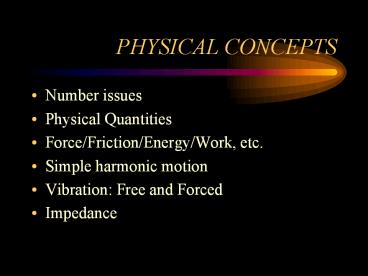PHYSICAL%20CONCEPTS - PowerPoint PPT Presentation
Title:
PHYSICAL%20CONCEPTS
Description:
PHYSICAL CONCEPTS Number issues Physical Quantities Force/Friction/Energy/Work, etc. Simple harmonic motion Vibration: Free and Forced Impedance ... – PowerPoint PPT presentation
Number of Views:73
Avg rating:3.0/5.0
Title: PHYSICAL%20CONCEPTS
1
PHYSICAL CONCEPTS
- Number issues
- Physical Quantities
- Force/Friction/Energy/Work, etc.
- Simple harmonic motion
- Vibration Free and Forced
- Impedance
2
Scientific Notation
- number between 1.00 and 9.99 times 10 raised to
some power - E.G.,
- 1492 becomes
- 1.492 x 103
- 1.492 is called the COEFFICIENT
3
Multiplying numbers in Sci. Not.
- Multiply coefficients
- sum powers of 10
- E.G.
- 2.3 x 102 x 4x103
- (2.3 x 4) x 10(23)
- 9.2 x 105
4
Dividing in Sci. Not.
- Divide Coefficients
- Subtract Powers of 10
- Read More About Exponents in Appendix A
5
Quantities Come in 2 Flavors
- Scalar Quantities
- magnitude only
- Vectorial or Vector Quantities
- magnitude AND direction
6
Scalar Quantities
- Have magnitude only
- Examples include Mass, Length, Volume
- Can be added or subtracted directly
7
Vector Quantities
- Have BOTH magnitude and direction
- Example Velocity
- Combining Vectors is more complicated
8
Basic Units
- Length
- Time
- Mass
- (Charge)
9
Other Units may be derived
- Area Length x Length (or L2)
- Volume L3
- Speed Length/Time
- Acceleration L/T2
10
Force A push or a pull
- Force Acceleration x mass
- Therefore Force ML/T2
- MKS force unit is Newton 1 kg m/s2
- cgs unit is dyne 1 g cm/s2
11
Force and Elasticity
- Hookes Law
- Force (-)spring constant times displacement
- Stress force per unit area (aka pressure)
- Strain change in length
- Stress Elasticity x Strain
12
Final Comment on Elasticity
- Compliance is the inverse of Stiffness
- Greater compliance yields more displacement per
unit force - Units L/ML/T2
- (meters/newton, or cm/dyne)
13
Friction
- Energy converted into heat when molecules rub
against each other. - To move an object, the applied force must
overcome friction. - Effect of Friction is Resistance
14
Friction produces Resistance
- Resistance ratio of Force to resulting velocity
(R f/v) - measured in Ohms
- Acoustically, we talk about the influence of
friction as DAMPING
15
Energy Related Concepts
- WORK
- POTENTIAL AND KINETIC ENERGY
- POWER
16
WORK
- Force applied through a distance
- No motion--no work
- Work force x distance ML/T2 x L
- Units JOULE 1 Newton Meter
- erg 1 dyne cm
17
ENERGY COMES IN 2 FLAVORS
- Kinetic-- Energy of motion
- (Inertia can be thought of as the ability to
store kinetic energy) - Potential--Energy of position
- (Elasticity --ability to store potential energy)
18
POWER
- Rate at which work is done
- Work/Time
- Unit Watt joule/second or 107 erg/sec
19
SIMPLE HARMONIC MOTION
- Vibration involves interplay of force, inertia,
elasticity, and friction - Applying a force displaces object
- Overcoming inertia
- Traveling away from rest until ?
20
Simple Harmonic Motion 2
- Why does object stop and then move back toward
rest? - Why doesnt the object then stop at rest?
- Where is potential energy the greatest?
- Where is kinetic energy the greatest?
21
SHM 3
- Why does displacement decrease over time?
- RESISTANCE
- -- Energy is lost to HEAT through FRICTION
22
SHM 4
- Amplitude --Displacement
- Period-- Time taken to complete one cycle
- Frequency--Number of Cycles per Second
- Phase--Describing points in the Cycle
23
A Waveform Shows Amplitude as a Function of Time
PEAK
PEAK-TO-PEAK
24
AMPLITUDE MEASURES
- Instantaneous- amplitude at any given instant
- Peak
- Peak to Peak
- Root Mean Square--A way of getting average
amplitude - Square root of Averaged Squared Amplitudes
25
Period and Frequency
- Frequency 1/Period (in seconds)
- Units of Frequency cycles per second or HERTZ
26
PHASE--Each cycle broken up into 360 degrees
- 0 degrees 0 displacement and about to head
positively - 90 degrees positive maximum
- 180 degrees0 disp. About to head negatively
- 270 degrees negative maximum
27
Phase Values Through a Cycle
90
180
270
360
28
FREE VIBRATION
- Pendulum illustration represents FREE VIBRATION
- Force applied and object allowed to respond
- Frequency of Free Vibration Resonant or Natural
Freq. - --determined by the objects Mass and Stiffness
29
FORCED VIBRATION
- Force is applied back and forth
- Vibration occurs at the frequency of the applied
force - Objects mass and stiffness determine amplitude
of vibration
30
IMPEDANCE
- The opposition to vibration, or
- What, other than motion, happens to your applied
force? - That is what do you have to overcome?
31
Impedance has 3 components
- Resistance Energy lost to heat through friction
- Mass Reactance Energy taken to overcome inertia
- Stiffness Reactance Energy taken to overcome
restoring force
32
Impedance and Frequency
- Resistance is generally the same across frequency
- Reactance Components change with frequency
33
Reactance and Frequency
- Mass reactance is greater at high frequencies
- --its harder to get massive objects to vibrate
quickly - Stiffness reactance is greater at low frequencies
- --its harder to get stiff objects to vibrate
slowly
34
Mass and Stiffness Reactance
Resonant Freq.
35
At Resonant Frequency
- Mass and Stiffness Reactance Cancel
- Only opposition to vibration is Resistance
- In Forced Vibration, you get the most vibratory
amplitude for amount of force applied































